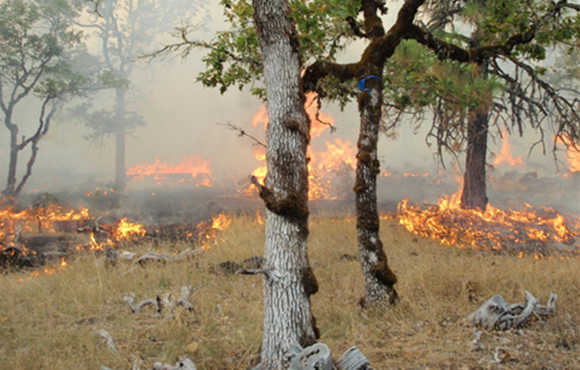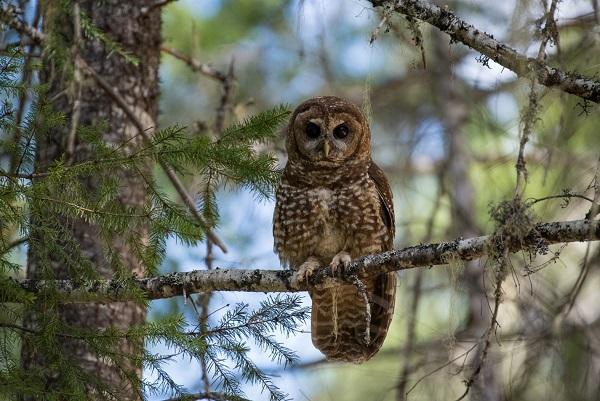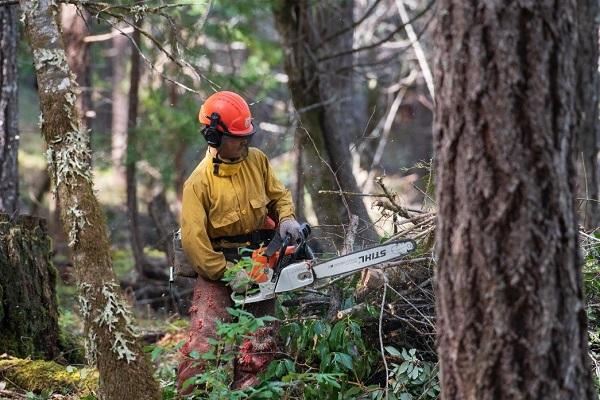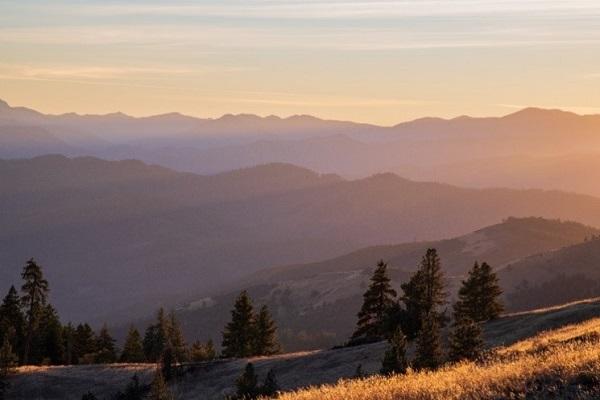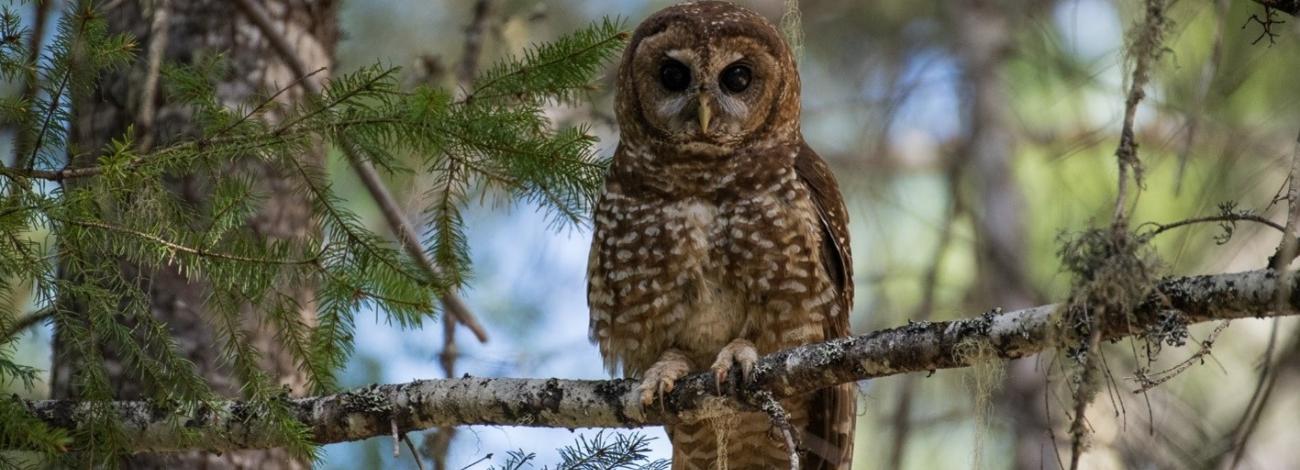
Integrated Vegetation Management
Forest Resilience Projects in the Medford District
Fire exclusion and other land management practices have created overly-dense forests susceptible to loss from change agents, such as climate change, drought, wildfire, insects, and disease. The BLM Medford District is tackling this issue head-on with the Integrated Vegetation Management for Resilient Lands Environmental Assessment (IVM-RL EA). The IVM-RL EA creates a toolbox for the BLM to increase the scope, scale, and pace of fuels treatments and vegetation management projects. This will allow the BLM to improve the health of forests, create safe and effective places for firefighters to engage, and address climate change. This work will encourage healthier forests that are more resilient to wildfire and drought, protect adjacent communities from large-scale wildland fires, and improve habitat for special status wildlife and plants. The IVM-RL EA is the BLM’s strategic approach to landscape-scale vegetation management that attempts to recouple vegetation patterns with topography influences. IVM isn’t new, but we’ve updated our analysis to carry successful projects into the future and meet management direction included in the 2016 RMPs.
The purpose of the IVM EA is to promote and develop:
- Safe and effective wildfire response opportunities that reduce wildland fire risk to Highly-Valued Resources and Assets* (HVRAs)
- Fire- and disturbance-resilient lands and fire-resistant stands
- Habitat for Special Status Species and unique native plant communities
* HVRAs as defined in the IVM-RL EA are Communities at Risk, northern spotted owl habitat and sites, marbled murrelet habitat and sites, special status plants, and special plant communities.
IVM Selected Alternative 2 Page Overview
Current IVM Projects
The BLM Medford District is working to increase the pace and scale of forest resilience projects across southwest Oregon. A growing number of projects have been developed using the IVM-RL EA framework.
- Agate Oak Project – Located southeast of Eagle Point, this project will treat up to 6,713 acres of hazardous fuels over five years. The project is part of the collaborative Upper Rogue Oak Initiative.
- Derbychain Fuels Reduction Project. Located 3 miles west of Butte Falls, this project authorizes 1,904 acres of prescribed fire and small diameter thinning.
- Late Mungers Integrated Vegetation Management Project. Located near Williams, this project authorizes 7,534 acres of non-commercial thinning and prescribed fire and 830 acres of commercial treatments.
- Table Rocks Fuels Reduction and Oak Habitat Restoration Project. Located on Upper and Lower Table Rocks near Medford, this project proposes 1,294 acres of non-commercial fuels treatments and oak restoration.
Future Potential Projects Planned for IVM
As the IVM-RL EA is programmatic in nature, it does not authorize ground-disturbing activities. Future decisions that approve site-specific treatments will be subject to environmental review. Examples of some projects that could be tiered to IVM include:
- Cook’s lomatium habitat management
- Baker Cypress habitat improvement
What the IVM Programmatic Decision Record Authorized
- Commercial treatments - 4,000 acres per year (0.6 percent of the Treatment Area); 20,000 acres over 10-years (2.9 percent of the Treatment Area).
- Small diameter thinning - 6,500 acres per year (1.0 percent of the Treatment Area); 60,000 acres over 10-years (8.7 percent of the Treatment Area).
- Prescribed fire - 7,500 acres per year (1.1 percent of the Treatment Area); 70,000 acres over 10-years (10.2 percent of the Treatment Area).
- Temporary road construction - 10 miles per year; 90 miles over 10-years (the BLM maintains approximately 5,000 miles of roads in the Medford District).
- Wildland Fire Risk Reduction
Southwest Oregon has a high concentration of communities with the highest cumulative wildfire risk [1]. The altered landscape, including fuel build up, in combination with drought conditions, continued expansion of human development into wildland areas, and checkerboard ownership patterns, make managing wildfire hazard increasingly complex and challenging. Trends and forecasts suggest that wildfire will continue to be a major change agent affecting ecosystems, further increasing wildfire risk across Oregon. The IVM-RL EA builds upon regional collaborative efforts that have identified similar needs for wildfire risk reduction, like the Rogue Valley Fire Integrated Community Wildfire Protection Plan.
The IVM-RL EA includes several thousand acres of prescribed fire and small diameter thinning and varies commercial thinning prescriptions when treatments are close to communities. Reducing fuel loading and interrupting fuel continuity can set forests up to better receive, persist, and thrive in the face of wildfire or prescribed fire. In a drought-prone and fire-prone region such as southwestern Oregon, reducing stand density and reintroducing characteristic low- and mixed-severity fire can also increase forest resilience and resistance to drought and insects. These actions to reduce surface, ladder, and canopy fuels can provide safe and effective places for firefighters to engage and contain a wildfire, limiting large fire growth and reducing wildfire risk to communities and other Highly Valued Resources & Assets.
Learn more about BLM Medford’s Fuel Treatment Effectiveness Monitoring at http://applegater.org/pdf/2021/v14n03/v14n03p14.pdf.
Sources:
[1] Recent analysis has identified 50 communities in Oregon with the highest cumulative wildfire risk (Scott et al. 2018); Scott, Joe H.; Gilbertson-Day, Julie; Stratton, Richard D. 2018. Exposure of human communities to wildfire in the Pacific Northwest. Briefing paper. 10 p. Available at: http://pyrologix.com/wp-content/uploads/2019/11/RiskToCommunities_OR-WA_BriefingPaper.pdf
- Resilient Lands
The Integrated Vegetation Management for Resilient Lands Environmental Assessment is an overview of BLM’s process to promote and develop forests resilient to climate change, drought, fire, insect infestations, and disease. The Western Oregon Resource Management Plan directs all actions in the Medford District and calls for BLM to implement 17,000 acres of commercial thinning or group selection harvest per decade in Late Successional Reserve Dry forests. These treatments are designed to enable forests to recover from past management measures; respond positively to climate-driven stresses, wildfire, and other disturbances with resilience; ensure positive or neutral ecological impacts from wildfire; contribute to northern spotted owl recovery; reduce the risk of loss of key late-successional structures; and increase diversity of stocking levels and size classes in forest stands and across the landscape.
There is a misunderstanding that Late Successional Reserve means we can’t or shouldn’t actively work in these areas. It’s actually the opposite, particularly in the dry forest. These are active management areas. Research demonstrates the need for disturbance (via thinning or fire) coupled with successional growth to develop structurally complex stands in the fire-adapted dry forests of Southern Oregon [2]. The current amount of mature and structurally-complex forest (51 percent) is substantially less than the average historical condition (58–80 percent). One significant goal of IVM is to create more structurally complex forests and promote and develop large fire-resistant trees.
Key Highlights of IVM-RL Resilience Objectives:
- Develop and retain legacy trees
- All conifer trees (pine and Douglas fir > 36 inches DBH that were established prior to 1850) and hardwoods >24 inches DBH would be retained
- Competing trees adjacent to legacy trees would be removed
- Clumps of fire tolerant legacy/relic trees with interlocking crowns would be retained
- Decrease fuel continuity to reduce risk of large-scale, high severity fires.
Sources:
[2] A regional evaluation suggests PNW dry forests need restoration via thinning and fire (Haugo et al. 2015). Haugo, R., C. Zanger, T. DeMeo, C. Ringo, A. Shlisky, K. Blankenship, M. Simpson, K. Mellen-McLean, J. Kertis, and M. Stern. 2015. A new approach to evaluate forest structure restoration needs across Oregon and Washington, USA. Forest Ecology and Management 335(1): 37–50. http://dx.doi.org/10.1016/j.foreco.2014.09.014.
- Develop and retain legacy trees
- Wildlife and Plant Habitat Improvement
Depending on the location, projects using the IVM EA would improve habitat for some of the Medford District’s Bureau sensitive and federally listed wildlife and plant species. The Recovery Plan for the northern spotted owl (2011, U.S. Fish & Wildlife Service) recommends active management in the frequent fire dry forest to promote resilient forests and support habitat persistence, as well as treating single-story, uniform forest stands to promote the development of multistory structure and nest trees. Gentner’s fritillary and Cook’s lomatium recovery plans recommend thinning, brushing, and/or burning to reduce encroaching vegetation, canopy cover, and the accumulation of thatch that suppresses growth and survival of rare plant species.
Key Highlights of IVM’s Habitat Improvement Objectives:
- Speed the development of northern spotted owl nesting-roosting habitat or improve the quality of northern spotted owl nesting-roosting habitat in the Late Successional Reserve. Develop stands with diversity, structure, layering, large trees, higher canopy cover, and other important habitat elements required to function as nesting-roosting habitat.
- Maintain northern spotted owl nesting-roosting habitat function (including key elements) at the stand-level in the LSR. Retain un-treated portions of stands (skips) to increase variability of forest conditions and to create desirable ecological conditions.
- Create conditions that are favorable for the initiation, creation, and retention of snags, down wood, and large vigorous hardwoods.
- Improve and restore meadows, grasslands, oak woodlands, and chaparral habitats by thinning encroaching conifers, hardwoods, and shrubs, as well as implementing prescribed fire.
The previous IVM Environmental Assessment was used to improve oak habitat in the Table Rocks Area of Critical Environmental Concern. The updated IVM allows the BLM to continue this critical work. Some IVM actions are designed to improve and develop nesting habitat in Late Successional Reserves for northern spotted owls and marbled murrelets (both federally listed as threatened under the Endangered Species Act), as well as other special status plants and wildlife. - Increased Pace and Scale of Treatments
The BLM is a small agency with a big mission. The Integrated Vegetation Management for Resilient Lands Environmental Assessment helps optimize our staff time by reducing repetitive analysis and creating a framework of actions to increase the pace and scale of treatments. Specialists will have more time to tailor treatments to individual forest stands. Additional site-specific analysis through a Determination of NEPA Adequacy document will address specific methods that accomplish desired outcomes, such as developing northern spotted owl nesting-roosting habitat, increasing fire resilience, building structural complexity, or facilitating tree diversity.
The IVM-RL EA is a critical component of implementing hazardous fuels reduction projects. BLM-managed public lands in the Medford District are interspersed among private lands and represent many of the communities with the highest cumulative wildfire risk. The landscape-scale approach of the IVM-RL EA increases our collaborative capacity to design and implement projects and allows us to be more competitive for funding to implement projects. In short, having the IVM EA in place allows the BLM to be responsive and flexible and to contribute to partner projects.
IVM allows BLM and partner organizations to better compete for funding to implement critical fuels treatments, ultimately increasing the pace and scale of treatments. Pictured here is the Rogue Forest Partners Williams Project implemented by Lomakatsi Restoration Partnership. - Climate Smart Planning
The United States faces a profound climate crisis, and the BLM is poised to take action to avoid the most catastrophic impacts of that crisis. The climate crisis is transforming where and how we live and presents growing challenges to human health and quality of life, the economy, and the natural systems that support us. The American people expect active and responsible management that is informed by science and public engagement. The BLM has worked diligently to meet that expectation in the development of the Integrated Vegetation Management Environmental Assessment.
IVM-RL treatments emphasize removal of suppressed, low vigor trees (e.g., exhibiting a poor-quality tree crown or those impacted by insects or diseases) and the development and retention of legacy trees. Reducing tree densities frees up water, growing space, and other nutrients for the remaining trees, increasing their vigor in the face of future disturbances as well as increasing diameter growth. The actions identified in IVM will increase tree species diversity while encouraging the development and retention of drought and fire tolerant tree species (e.g., oak and pine).
- Planning/Public Participation
The BLM engaged in extensive public engagement in the development of the IVM EA. Over the course of the three years, the BLM held three comment periods for a total of 114 days and reviewed more than 1,300 public comment letters and emails. At a minimum, the BLM will provide additional public engagement opportunities for future projects involving commercial harvesting treatments under the IVM EA.
Learn more about the IVM EA by visiting the project website at: https://eplanning.blm.gov/eplanning-ui/project/123406/510
This section will be updated as public engagement opportunities are available for projects tiered to the IVM EA.


